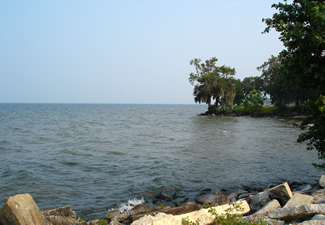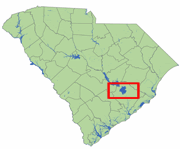Lake Moultrie

Lake Moultrie is the third largest lake in South Carolina (60,400 acres) and is located within Berkeley County.� It is the smaller of the two coastal plain impoundments that comprise Santee Cooper Reservoir.� Constructed in the Cooper River Drainage, over half its shoreline is contained within a network of Dams and Dikes.� This depression era electrification project was originally designed to route the Santee River flow down the Cooper River.� However, since 1985 flow has been re-diverted to the Santee River through an Army Corp of Engineers canal and hydroelectric dam located near the town of St. Stephen.� The St. Stephen Dam is equipped with a fish lift that allows passage upstream for sea run anadromous fish species like American shad and blueback herring.� Lake Moultrie�s Pinopolis Dam has a boat lock that allows both boat traffic and anadromous fish passage.�
Most of Lake Moultrie, unlike Lake Marion, was timbered before impoundment.� However, caution is urged when navigating in shallow water on Lake Moultrie, as many submerged stumps are present on its gently sloping shorelines. �Aquatic vegetation is present in backwater sloughs and in the 900 acre Hatchery section of the lake.� Originally constructed to be a separate impoundment within Lake Moultrie, the remnants of the Hatchery dike still provide enough shelter to allow significant aquatic vegetation growth that provides habitat for largemouth bass, pickerel, bream, and many other species. �Once away from the shoreline, the stump hazards decrease and the majority of Lake Moultrie is suitable for pleasure boaters and fisherman alike.� Much of the open water varies in depth from 10 feet to 30 feet deep, as numerous underwater humps and contour breaks exist throughout the lake.� The lake is 14 miles across at its widest point, and a marked navigational channel runs from Pinnopolis Dam to the Diversion Canal.
The closure of Lake Marion Dam in 1941 trapped a founding population of striped bass and a thriving population developed in the reservoir. Investigations of this population first demonstrated that striped bass could complete its life cycle entirely in freshwater.� The striped bass fishery has declined in recent years due to a variety of factors, but recent steps taken to rebuild the population have had positive results.� Blue catfish and flathead catfish were introduced into the system in the mid-1960s.� They have readily adapted to the Santee Cooper lakes system and today provide many anglers with the opportunity to catch the largest freshwater fish they will ever encounter.� Largemouth bass and shellcracker fisheries also draw anglers each spring, providing unique opportunities to catch large fish.
General Information

Miles of Shoreline: 210.24
Acres of Surface Water: 60,400
Counties Lake is Within: Berkeley
Average Depth: 18.7 feet
Maximum Depth: Approximately 75.46 feet
Boat Ramps: 8
Fish Attractors: 19
Fishing Access Locations: 1
Fishing Loaner Tackle Locations: None
Owned and Managed by: Santee Cooper
